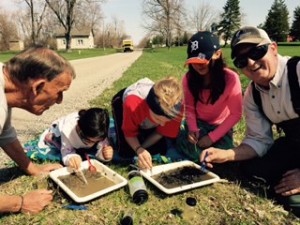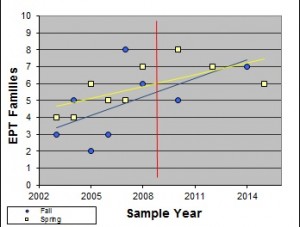
People enjoying nature!
We could not have asked for better spring weather for our 120 volunteers on April 18! They soaked in the sun and warmth while visiting 50 different creek and river locations across the Huron River Watershed. Held twice a year, HRWC’s River Roundup is one of the most effective ways that HRWC has to understand how the water quality of the river and creeks may be changing. From the macroinvertebrates collected during this event, we are able to keep abreast of the health of our waterways throughout the watershed. You can see all the results in April 18 River Roundup Report.
Highlight
Mill Creek is the largest tributary to the Huron River, draining 143 square miles of land, 68 of which are agriculture. Agricultural impacts have certainly taken their toll on Mill Creek, with some Mill Creek’s tributaries no more than straightened ditches, and the creek has phosphorus and E.Coli issues that come from fertilizers and animals. However, great things are happening in Mill Creek, including the removal of Mill Pond Dam in Dexter, stream stabilization projects, landowner education, and a renewed interest in bringing residents to the waterfront.

As a part of the River Roundup, volunteers regularly visit 9 sites on Mill Creek (the main branch and several tributaries). Four of these sample sites are showing significant improvements in the macroinvertebrate populations, indicating improving water quality and habitat. These four sites are Shield Road (near the mouth), Manchester Road and Klinger Road (both in the headwaters), and Fletcher Road (on the north branch).
Shield Road in particular seems to be doing quite well with several highly diverse samples taken since the removal of the downstream dam. The graph to the right shows the changes in the EPT (mayfly-stonefly-caddisfly) family diversity, with the red line in the middle of the graph indicating the dam removal. Samples in the early 2000’s were particularly poor with only 2 or 3 families found, and now we are regularly finding 6 or 7. Insect families that are now found which were not found previously include Baetid mayflies, Isonychia mayflies, Leptophlebia mayflies, and the Philopotamid caddisfly.
You can learn more about Mill Creek from our creekshed report.
Lowlight

If you have read these updates before, you will recall that we have learned that several streams in Livingston County have had significant reductions in their insect populations over time. In fact, of the 62 sites that we monitor across the Huron River Watershed, 20 are in Livingston County, and 9 of those have statistically significant reductions. In contrast, HRWC monitors 30 sites in Washtenaw County and the insects at 12 sites are statistically improving while zero are declining. Now, this may simply be a coincidence, as it is difficult to explain why a political boundary can make such a difference in insect populations. But the data speaks pretty clearly; among others, Davis Creek (South Lyon area) has been declining, and South Ore Creek (Brighton area) is also getting worse. Thankfully, both of these creeks could still be considered relatively healthy (when compared to more heavily urbanized creeks like Malletts), but we have to make some extra efforts to get these creeks to reverse their negative trends.
What’s next?
You should be a creekwalker! In this unique program, you will walk up and down a stream, exploring it and looking for possible pollution sources. Join by yourself, with friends, or with your family. Learn more about it at http://www.hrwc.org/volunteer/creekwalker/.



